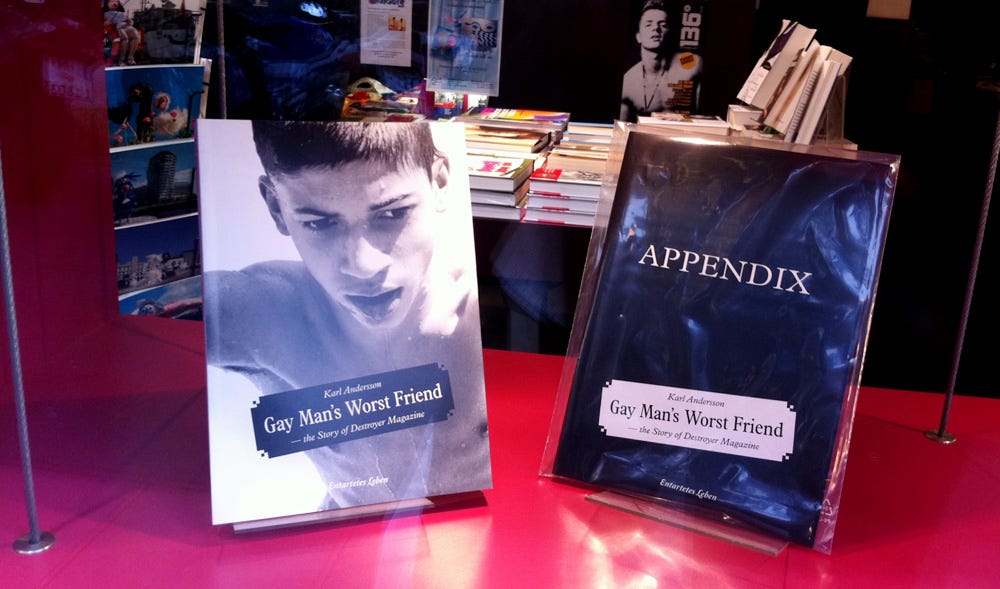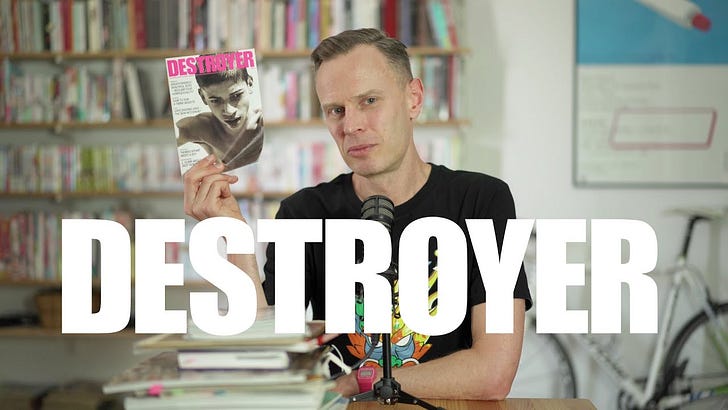Destroyer dropped like a bomb. My new gay magazine made headlines in Swedish newspapers, was debated on prime time radio, and was fiercely discussed on blogs, the social media of the time, because this was in 2006.
So what was all the fuss about?
It was about the boys. The young men who modeled in the magazine, thereby suggesting that some gay men might find them attractive. This awakened the old myth of “homosexual seduction,” both among homophobes, who gloated “we told you so,” and among gay men, who exclaimed in panic that “we’re absolutely not like that!”
Destroyer’s mission was to take back the young man as one of the beauty ideals of gay culture, alongside the masculine, mature man, who had come to monopolize gay media in recent decades.
A radical mission.
And a dangerous one.
I can with certainty say that my decision to publish Destroyer changed my life forever. As “the Destroyer guy,” I lost freelance work and was cut from a non-fiction anthology that I was originally planned for.
It wouldn’t be the last time.
Boys Beware!
Even now, almost 20 years later, Destroyer influences my life.
When a British university expelled me in 2022 for having published an article in a scientific journal – of course after supervisor approval and raving peer reviews – they cited my previous publishing as the actual ground. Because of what my previous publishing indicated about me.
The only thing my previous publishing “indicates” about me is that I’m a gay man. So kudos for using the oldest trick in the book and ousting a homosexual from your supposedly so “inclusive” ranks, Manchester! The whole thing reminds of the 1961 American propaganda film Boys Beware, which warned teenage boys of “mentally ill homo-sexuals.” (Can be watched here.)
If you’re interested in my full take on the “masturbation scandal” at Manchester (including the reference to Boys Beware), I write about it in my book Impossibly Cute Boys (affiliate link: as an Amazon associate I earn from qualifying purchases).
You’re Out!
In the midst of the scandal at Manchester, I was contacted by the editor of an anthology which I was to be included in. It was a prestigious academic book that would be published by a university press, and the editor had told me earlier that he considered my contribution one of the most important.
But now he wanted to talk on Zoom.
During our long meeting, he expressed genuine concern about my health, told me how wrong he thought the treatment of me had been, and how amazing it was that I did what I was doing. “This is art,” he said. But at the end of the meeting, almost in passing, he mentioned that he unfortunately had had to cut me from the anthology, since the other contributors might not feel comfortable with my participation in it.
Or that I would steal the show.
Or whatever the formal reason was.
I realized how hard it must have been for him to make this call. Because the purpose with it was not to check up on my well-being or tell me how great I was. That part was only the preparation for the real purpose: to tell me in a gentle way that I was – out.
Isn’t this fascinating? Professional editors sacrificing the quality of a book, the quality of research, for ... for what? Fear of the public opinion? Fear of me? Or just fear in general?
Berns Goes Gay
I have a long publishing career. In my early twenties, after having written for the two gay magazines in Sweden, I managed to place gay-themed articles in the big newspapers.
I still remember the thrill when I decided to call the newspaper instead of the gay magazine to place an interview I had done with a club promoter who was to hold a gay party at Berns, a famous and classy entertainment venue in central Stockholm. Until then, gay clubs usually resided in dark basements.
I was 22 and had a hard time getting my message through on the landline phone in the gay co-op house where I lived, nervous as I was.
The editor interrupted me:
What is it that you want to say?
I realized the importance of this question – the editor had given me a chance. I composed myself and told him in one sentence:
That both gay history and club history is written with this gay party being held at one of Stockholm’s most prestigious venues.
I could almost hear the editor’s excitement. He asked me to mail the article – yes, print it out on paper and send it to him in an envelope, because this was in 1997. I put it in the mailbox the same evening.
The next Friday, my article was published on a full page in the entertainment supplement. My career had taken off. (And so had the club promoter’s: the line to the entrance reached about 200 meters, and the night was a success)
Karl Goes Straight
As I made myself a name as a gay-themed freelance writer for the mainstream newspapers, I was approached by several media houses that had started to notice me and wanted me to work for them.
But I was studying for my BA at Stockholm University. I had been accepted to a specialized program in “language consultancy,” that only let in 20 students every second year, based on their results on a writing test that was taken by 450 applicants. I didn’t want to give up that!
But when I was asked to become editor-in-chief of Sweden’s first glossy lifestyle magazine aimed at gay men, I decided to take a year off my studies (or two years, technically, since my program only ran every second year).
During an intensive year, I created, launched, and promoted Straight, as the magazine was called (it was named before I was hired). I did plenty of interviews, participated in live TV and radio shows, and mingled with readers and advertisers at several release parties (each issue had its own). I became “Straight-Karl,” a weird moniker for a gay man. I still remember the laughter among my fellow gay journalists on a trip to Miami (the city of Miami had invited editors of European gay magazines) when my name tag simply said: “Karl Andersson, Straight.” And I still laugh at it!
Ideal esthetics
After going back to my studies, getting my degree, and living abroad, I started working for several media houses in Stockholm. But one thing had changed: instead of being a “text person” who wrote and edited, I became employed as a layouter, and after a while advanced to art director.
The magazine that was most influential to me was Slitz, Scandinavia’s biggest men’s magazine, you know, the type that has half-naked women on the cover (but which doesn’t contain any porn).
I loved working at Slitz. I loved how everything we did had one purpose: to create an ideal that could be sold to the readers. An ideal in the form of the perfect woman who graced the cover of each issue. I loved following the process from the selection of the model in the agency’s catalog, to the photo shoot, the clothes the stylist chose for the model, the poses the photographer asked her to strike, and of course the model’s own work, but also the post-photography work that was done by the magazine’s retouch person, and, not least, the final selection of the images that would go into the magazine.
It’s a process of worship – the creation and worshipping of an ideal.
If I was culturally and politically primed at Straight, Slitz primed me visually.
Designing Destroyer
So when I in 2006 created the first issue of Destroyer, after having newly moved to Prague in the Czech Republic, I designed it as Slitz.
Gay culture in straight form?
I don’t know.
But I know that the idea to put young men on the cover in poses that are traditionally reserved for women shocked some people and probably contributed to the controversy that surrounded the magazine.
Of course, the content of the articles was also controversial. I argued that the gay movement had sacrificed male attraction to young men in order to reach acceptance. I accused the gay movement post-Stonewall of not being about “pride” but about “shame.”
It was a harsh indictment, and it came from the inside.
I published Destroyer in ten issues over four years. My book Gay Man’s Worst Friend: The Story of Destroyer Magazine describes the project in detail, and particularly the reactions it caused. It’s sold out, but if there is interest, I might republish it.

When Track Record Becomes Baggage
Fast forward a decade or so. I went back to academia, took a master’s degree in anthropology, and started a PhD program in the UK.
You know the rest.
When the scandal in Manchester broke, it wasn’t only about the article itself, but also about my publishing history. Yes, the scandal had enough fodder to feed the tabloids and the twitter mob for days! But that’s ok. Populism is always homophobic, and it’s no surprise that tabloids want to stir up panic among their readers – that’s their job!
It’s another matter altogether when normally rational and intellectually well-functioning people and institutions adopt the rhetoric of Daily Mail and start bullying the gay man.
Because that’s what it boils down to. Classic, old-school homophobia, but draped in new, shiny phrases about “risk of harm” to “vulnerable populations” (quoting from my head now, not an expert in this lingo).
Actually, that’s not just homophobia. It’s homophobia galore!
As I said, Boys Beware!
Destroyer, my dear. You keep causing troubles. The magazine I launched almost 20 years ago would eventually, together with the publications in its wake, lead to my expulsion from academia.
You impress me.
Because your far-reaching impact must be a sign that you were important. That you had something to say.
Real Journalism
So what was all the fuss about?
Well, why don’t you see for yourself!
Because of the renewed interest in Destroyer during the most recent scandal, I decided to republish the articles from this long since sold out magazine in a book.
I present to you:
Real Journalism: Self-Published Writings on Sexual Politics, History and Culture
(Affiliate link, as an Amazon associate I earn from qualifying purchases.)
In this 300 page volume, I have collected and carefully remastered 57 of the best articles that I wrote in Destroyer and its sequel The Lover.
In addition, I’ve written a new introduction about why I published the magazines, their continued relevance, and how I feel about them today.
Real Journalism does not contain any images. That was for the magazines. No boys or young men to drool over here – if you don’t count the slightly younger me on the cover of course!
The people who are reading it so far are flabbergasted: This is quality journalism! they exclaim. This is serious cultural criticism, not at all the filth that the tabloids went on about!
Yeah, I know.
The articles from Destroyer and The Lover are living gay culture.
Even more importantly, the book contains some real investigative journalism. It digs into cases that mainstream media won’t touch. It contains stories that are not published elsewhere.
Not least, it’s fun! Or at least I hope so.
I’m really happy that this book is out now. Really proud of it.
Real Journalism is not for everyone. But if it’s for you, then I’m happy if you read it. Get it while you can, you never know the whims of independent publishing.
Take care and talk to you soon!
/Karl
PS: Did you know that my newsletter Real Research has a Discord server with the same name? Here’s an invite! From there you can also join our Signal group.
Also, I remade my homepage!
And as always, I keep publishing videos on my Youtube channel!










